You’ve bought the perfect bottle of wine but if you want to get the wine into your glass you likely have to own a tool.
Nearly everyone, including the infrequent wine drinker, owns a wine opener of some sort. Tragically, most have shoddy tools more adept at shredding corks than removing them. There is no need to have an inferior wine opener or to fear the process.
The fear of breaking corks or simply “doing it wrong” has sparked the invention of fancy and often expensive wine openers that promise the make the process effortless and foolproof. P.T. Barnum famously said, “There’s a sucker born every minute.” Don’t be a sucker. My favorite wine opener cost around $10.
As will become abundantly clear I am a huge fan of the classic waiter’s corkscrew and I rarely use other tools (you will have to read the rest to what other tools I occasionally use).
| Screwcaps Not really a wine opener – or is it? Fortunately, wine drinkers have finally embraced screwcaps on their wine bottles. The great advantage of the screwcap is that there is no tool required. Another advantage is that the possibility of the wine being tainted has been greatly reduced with the use of the screwcap. When considering the vast majority (more than 90%) of all wines are consumed within two years of bottling, the concerns of aging are insignificant to most consumers. If you still believe that only inferior wines have screwcaps, I invite you to join the rest of us in the 21st century and embrace screwcaps. |
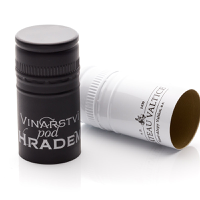 No Tool required |
| The Waiter’s Corkscrew This is by far the most recognizable cork extractor. Every waiter and bartender worth their salt has one in their apron or pant pocket. It’s ultra-portable and rugged, and once you become comfortable using the waiter’s corkscrew you will likely never use another type of wine opener. The modern waiter’s corkscrew now features a double hinge that makes it easy to pull longer corks without bending and potentially breaking the cork. If you have a lightweight waiter’s corkscrew with a plastic handle and a wimpy worm (the twisted screw that penetrates the cork) throw it away and get yourself a HiCoup waiter’s corkscrew like I use. The waiter’s corkscrew also has the great benefit of being a multi-tasker opening bottles of beer with ease. |
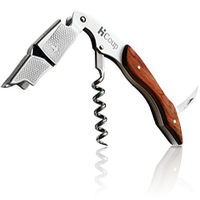 The Classic Waiter’s Corkscrew |
| The Winged Corkscrew In a kitchen drawer of every vino drinker who fears the waiter’s corkscrew, you will find the winged corkscrew. This slightly medieval-looking device relies on simple mechanics. The worm is screwed into the cork by turning the nut at the top and then the cork is lifted from the bottle by pulling down the raised wings as the gears do the work. The problem is that most winged corkscrews have a bulky and clumsy worm that shreds the center of the cork leaving the rest of the cork in the bottle. For this reason, I can only recommend this type of tool to those who are forever intimidated by the waiter’s corkscrew. |
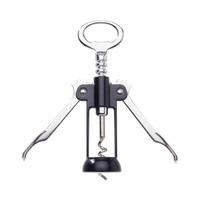 The Winged Corkscrew |
| Tabletop (or table mount) Opener The first asset of this style of opener is that it looks so damn cool. The obvious downside of this type of wine opener is that it is rather larger and takes up a lot of space. The tabletop wine opener is only practical if you are a commercial operation like a bar or tasting room or if at home you have a dedicated wine table near your wine stash. If you go this route be sure to secure it to the table so you can operate the opener with total confidence gripping the bottle with one hand and operating the lever with the other. Also, don’t go the cheap route when buying this model as you may be tempted by $35 version but this will end badly. Be prepared to spend $70 to $100 for a wine opener you will have forever. |
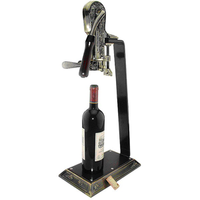 Table Top Corkscrew |
| The Lever (Rabbit Style) Corkscrew This wine opener style became all the rage about two decades ago and it still has a loyal following. I have never been a fan of this style of opener. The basic mechanics of this opener work like the tabletop or table mount models as the lever is pushed down to insert the worm into the cork and then lifted to pull the cork from the bottle. The problem is that unlike the tabletop model the opener and the bottle are not secure. You must pinch two handles to grip the bottle top while working the lever with the other hand. The pitch is that it is a fluid motion but that is not always the case. Another issue with this style of opener is that you have to pay close to $100 to get a quality version. Even if you love this style you better be prepared to frequently replace the worm (many are sold with an extra spiral worm) and also be prepared to give up a lot of drawer space to this monster. |
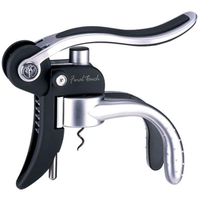 The Lever Corkscrew |
| The Ah-so (Two Pronged) Cork Extractor Most of you have never used an ah-so cork extractor and that’s okay. I know that some of you are looking at this strange little object and wondering how it can possibly remove a cork from a bottle. I have an ah-so or two in my drawer but it rarely gets used but it is an indispensable tool for a portion of wine drinkers. If you cellar wines for a decade or more you have undoubtedly encountered a cork that looked a bit brittle once the foil had been removed. If the cork is old, long, or brittle the ah-so is the absolute best tool for the job. The ah-so is used by gently inserting the longer prong between the cork and bottle followed by the shorter prong and then by using a gentle rocking motion slowly working the prongs down the neck of the bottle. Once inserted pull while slowly twisting the ah-so to remove the cork. The ah-so is cheap and easy to store but the downsides are considerable as it is very tricky to use and it works poorly on synthetic corks. |
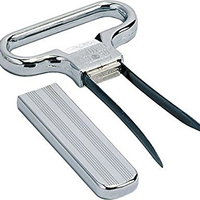 The Oddly Named Ah-so |
| The Air Pump (or compressed air) Opener This odd and medical-looking device was all the rage years ago and now I rarely see anyone using it. It works on a simple principle of inserting sufficient air pressure into a bottle until the cork is forced out often with a pop that turns every bottle of wine into a Champagne-like experience. This opener was derided by many wine purists who suggested that pressure, albeit temporary, was bad for the wine. I think that this is a mythical concern. However, I once experienced a genuine concern while using an air pump opener years ago when to my surprise the bottom of the bottle was blown out well before the cork gave way. After I was finished cleaning up the red wine that sprayed everywhere in my kitchen the air-pump opener went into the drawer never to be used again. |
 The Air Pump Extractor |
| The Electric Wine Opener When I first saw one of these sleek electric wine openers I thought, how lazy must you be to buy one of these damn things? I must admit that they are cool to use the first few times but I find that it takes away the simple joy of extracting a cork. Additionally, it removes you from the touch and feel that is so important if the cork is destined to break. While I do not need this style of opener I do love this option for the vino drinker who has a disability that makes the use of the traditional corkscrew painful or even impossible. |
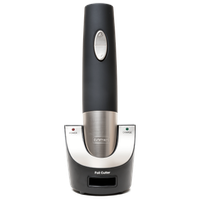 Electric Wine Opener |
| The Classic Turn and Pull Corkscrew If you are a sucker for anything old-school this model is for you. We have all seen one of these corkscrews and most of us have one kicking around the kitchen junk drawer. The operation is simple in theory and frequently a physical challenge in reality. The more grim reality is that this style of corkscrew has shredded as many corks as it has pulled and has pushed a fair many corks into the bottle. I don’t want to be entirely negative about the turn-and-pull corkscrew as they are quite nostalgic and it is the perfect tool to offer your unwelcome party-crasher. |
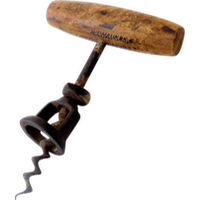 Turn and Pull Corkscrew |
| The Hammer I hope that it never has to come to this – the use of the hammer to open a bottle. If all traditional attempts have failed you may be considering desperate measures. However, I must point out that there have been very few successful attempts to open a bottle of wine with a hammer. If you have reached this level of frustration may I please direct you to Youtube to view the many examples of people opening a bottle of vino with a shoe. No, that’s not a typo, I said a shoe. |
 Never Use a Hammer |
